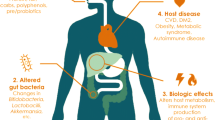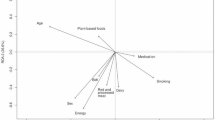Abstract
The dietary patterns are closely associated with gut microbiota, which has been proved associated with kidney stones. To assess the association among the dietary patterns, gut microbiota, and kidney stones, patients with calcium oxalate stones and participants without kidney stones were recruited in West China Hospital and were divided into the low nephrolithiasis risk (LNR) and high nephrolithiasis risk (HNR) dietary pattern group based on the results of food frequency questionnaires. The genomic DNA of the fecal samples were extracted for 16S ribosomal RNA gene sequencing. The non-kidney stone (NS) group comprised 39 LNR and 45 HNR individuals, while the kidney stone (KS) group consisted of 19 LNR and 50 HNR individuals. The distribution of oxalate in urine (p < 0.01) but not calcium (p = 0.741) was significantly varied among the four groups. Significant difference was found in the dietary patterns of people with KS and NS controls (X2 = 5.744, p = 0.017). Forty-six discriminative bacteria were found among different dietary patterns groups in KS patients and NS controls. Not only gut bacteria such as Pseudomonas, Sphingomonas, Hydrogenoanaerobacterium, Faecalitalea, etc., but also metabolic pathways associated with inflammation, lipid, and mineral metabolism were found more abundant in KS patients with HNR dietary pattern. It is noteworthy that g__Prevotellaceae_UCG_001, g__hgcI_clade, and g__Bradyrhizobium were negatively related to water intake but instead had a positive correlation with salt and meat intake. Our study revealed that gut microbiota with significantly different abundance existed in the HNR dietary patterns compared to the LNR counterparts in both calcium oxalate KS and NS individuals. The dietary patterns may affect the prevention and management of calcium oxalate stones by regulating the homeostasis of gut microbiota.




Similar content being viewed by others
References
Antonelli JA, Maalouf NM, Pearle MS et al (2014) Use of the National Health and Nutrition Examination Survey to calculate the impact of obesity and diabetes on cost and prevalence of urolithiasis in 2030. Eur Urol 66(4):724–729. https://doi.org/10.1016/j.eururo.2014.06.036
Bernard K (2012) The genus corynebacterium and other medically relevant coryneform-like bacteria. J Clin Microbiol 50(10):3152–3158. https://doi.org/10.1128/JCM.00796-12
Della Guardia L, Roggi C, Cena H (2016) Diet-induced acidosis and alkali supplementation. Int J Food Sci Nutr 67(7):754–761. https://doi.org/10.1080/09637486.2016.1198889
Escribano J, Balaguer A, Roqué i Figuls M et al (2014) Dietary interventions for preventing complications in idiopathic hypercalciuria. Cochrane Database Syst Rev. https://doi.org/10.1002/14651858.CD006022.pub4
Falony G (2018) Beyond: the gut microbiota and kidney stone formation. Gut 67(12):2078–2079. https://doi.org/10.1136/gutjnl-2018-316639
De Filippo C, Cavalieri D, Di Paola M et al (2010) Impact of diet in shaping gut microbiota revealed by a comparative study in children from Europe and rural Africa. Proc Natl Acad Sci USA 107(33):14691–14696. https://doi.org/10.1073/pnas.1005963107
Flores-Treviño S, Bocanegra-Ibarias P, Camacho-Ortiz A et al (2019) biofilm: its role in infectious diseases. Expert Rev Anti Infect Ther 17(11):877–893. https://doi.org/10.1080/14787210.2019.1685875
Fu R, Niu R, Li R et al (2020) Fluoride-induced alteration in the diversity and composition of bacterial microbiota in mice colon. Biol Trace Elem Res 196(2):537–544. https://doi.org/10.1007/s12011-019-01942-w
Hao YT, Wu SG, Xiong F et al (2017) Succession and fermentation products of grass carp () hindgut microbiota in response to an extreme dietary shift. Front Microbiol 8:1585. https://doi.org/10.3389/fmicb.2017.01585
Hooda S, Boler BMV, Serao MCR et al (2012) 454 Pyrosequencing reveals a shift in fecal microbiota of healthy adult men consuming polydextrose or soluble corn fiber. J Nutr 142(7):1259–1265
Huang S, Pang D, Li X et al (2019) A sulfated polysaccharide from Gracilaria Lemaneiformis regulates cholesterol and bile acid metabolism in high-fat diet mice. Food Funct 10(6):3224–3236. https://doi.org/10.1039/c9fo00263d
Institute of Nutrition and Food Safety, C. D. (2005) China Food Composition 2004. Peking University Medical Press, Beijing. https://doi.org/10.3390/nu9040406
Jang HB, Choi M-K, Kang JH et al (2017) Association of dietary patterns with the fecal microbiota in Korean adolescents. BMC Nutrition 3(1):20
Jung M-J, Lee J, Shin N-R et al (2016) Chronic repression of mTOR complex 2 induces changes in the gut microbiota of diet-induced obese mice. Sci Rep 6:30887. https://doi.org/10.1038/srep30887
Kang X, Zhan L, Lu X et al (2020) Characteristics of gastric microbiota in GK rats with spontaneous diabetes: a comparative study. Diabet Metab Syndr Obes 13:1435–1447. https://doi.org/10.2147/DMSO.S242698
Kelsey R (2016) Stones: Gut microbiome is unique in kidney stone disease. Nat Rev Urol 13(7):368. https://doi.org/10.1038/nrurol.2016.93
Kevans D, Tyler AD, Holm K et al (2016) Characterization of intestinal microbiota in ulcerative colitis patients with and without primary Sclerosing Cholangitis. J Crohns Colitis 10(3):330–337. https://doi.org/10.1093/ecco-jcc/jjv204
Kovacevic L, Lu H, Caruso JA et al (2017) Marked increase in urinary excretion of apolipoproteins in children with nephrolithiasis associated with hypercalciuria. Pediatric Nephrol (Berlin, Germany) 32(6):1029–1033. https://doi.org/10.1007/s00467-016-3576-1
Langille MGI, Zaneveld J, Caporaso JG et al (2013) Predictive functional profiling of microbial communities using 16S rRNA marker gene sequences. Nat Biotechnol 31(9):814–821. https://doi.org/10.1038/nbt.2676
Lembo-Fazio L, Billod J-M, Di Lorenzo F et al (2018) Lipid A: immunological properties and molecular basis of its binding to the myeloid differentiation protein-2/toll-like receptor 4 complex. Front Immunol 9:1888. https://doi.org/10.3389/fimmu.2018.01888
Leone A, Fernández-Montero A, de la Fuente-Arrillaga C et al (2017) Adherence to the mediterranean dietary pattern and incidence of nephrolithiasis in the Seguimiento Universidad de navarra follow-up (SUN) cohort. Am J Kidney Dis 70(6):778–786. https://doi.org/10.1053/j.ajkd.2017.06.027
Lin H, Zhu X, Long J et al (2018) HIPK2 polymorphisms rs2058265, rs6464214, and rs7456421 were associated with kidney stone disease in Chinese males not females. Gene 653:51–56. https://doi.org/10.1016/j.gene.2018.02.020
Liu Y, Jin X, Hong HG et al (2020) The relationship between gut microbiota and short chain fatty acids in the renal calcium oxalate stones disease. FASEB J. https://doi.org/10.1096/fj.202000786R
McLean RM, Williams SM, Te Morenga LA et al (2018) Spot urine and 24-h diet recall estimates of dietary sodium intake from the 2008/09 New Zealand Adult Nutrition Survey: a comparison. Eur J Clin Nutr 72(8):1120–1127. https://doi.org/10.1038/s41430-018-0176-0
Mehta M, Goldfarb DS, Nazzal L (2016) The role of the microbiome in kidney stone formation. Int J Surg 36(Pt D):607–612. https://doi.org/10.1016/j.ijsu.2016.11.024
Miller AW, Choy D, Penniston KL et al (2019) Inhibition of urinary stone disease by a multi-species bacterial network ensures healthy oxalate homeostasis. Kidney Int 96(1):180–188. https://doi.org/10.1016/j.kint.2019.02.012
Nouvenne A, Meschi T, Prati B et al (2010) Effects of a low-salt diet on idiopathic hypercalciuria in calcium-oxalate stone formers: a 3-mo randomized controlled trial. Am J Clin Nutr 91(3):565–570. https://doi.org/10.3945/ajcn.2009.28614
Ramees TP, Dhama K, Karthik K et al (2017) Arcobacter: an emerging food-borne zoonotic pathogen, its public health concerns and advances in diagnosis and control—a comprehensive review. Vet Q 37(1):136–161. https://doi.org/10.1080/01652176.2017.1323355
Rieber H, Frontzek A, Schmitt H (2019) Slackia exigua, an anaerobic Gram-positive rod and part of human oral microbiota associated with periprosthetic joint infection of the hip. First case and review of the literature. Anaerobe 56:130–132. https://doi.org/10.1016/j.anaerobe.2019.02.015
Rodgers AL, Lewandowski S (2002) Effects of 5 different diets on urinary risk factors for calcium oxalate kidney stone formation: evidence of different renal handling mechanisms in different race groups. J Urol 168(3):931–936
Shadman A, Bastani B (2017) Evaluation and management of kidney calculi. Iran J Kidney Dis 11(6):395–407
Shikany JM, Demmer RT, Johnson AJ et al (2019) Association of dietary patterns with the gut microbiota in older, community-dwelling men. Am J Clin Nutr 110(4):1003–1014
Shoskes DA, Wang H, Polackwich AS et al (2016) Analysis of gut microbiome reveals significant differences between men with chronic prostatitis/chronic pelvic pain syndrome and controls. J Urol 196(2):435–441. https://doi.org/10.1016/j.juro.2016.02.2959
Siener R, Hesse A (2002) The effect of different diets on urine composition and the risk of calcium oxalate crystallisation in healthy subjects. Eur Urol 42(3):289–296
Sobhonslidsuk A, Chanprasertyothin S, Pongrujikorn T et al (2018) The association of Gut Microbiota with Nonalcoholic Steatohepatitis in Thais. Biomed Res Int 2018:9340316. https://doi.org/10.1155/2018/9340316
Song X, Zhong L, Lyu N et al (2019) Inulin can alleviate metabolism disorders in ob/ob mice by partially restoring leptin-related pathways mediated by gut microbiota. Genom Proteom Bioinform 17(1):64–75. https://doi.org/10.1016/j.gpb.2019.03.001
Stern JM, Moazami S, Qiu Y et al (2016) Evidence for a distinct gut microbiome in kidney stone formers compared to non-stone formers. Urolithiasis 44(5):399–407. https://doi.org/10.1007/s00240-016-0882-9
Suryavanshi MV, Bhute SS, Jadhav SD et al (2016) Hyperoxaluria leads to dysbiosis and drives selective enrichment of oxalate metabolizing bacterial species in recurrent kidney stone endures. Sci Rep 6:34712. https://doi.org/10.1038/srep34712
Tang R, Jiang Y, Tan A et al (2018) 16S rRNA gene sequencing reveals altered composition of gut microbiota in individuals with kidney stones. Urolithiasis 46(6):503–514. https://doi.org/10.1007/s00240-018-1037-y
Tavichakorntrakool R, Prasongwattana V, Sungkeeree S et al (2012) Extensive characterizations of bacteria isolated from catheterized urine and stone matrices in patients with nephrolithiasis. Nephrol Dial Transplant 27(11):4125–4130. https://doi.org/10.1093/ndt/gfs057
Thamilselvan S, Hackett RL, Khan SR (1997) Lipid peroxidation in ethylene glycol induced hyperoxaluria and calcium oxalate nephrolithiasis. J Urol 157(3):1059–1063
Valdezate S, Garrido N, Carrasco G et al (2017) Epidemiology and susceptibility to antimicrobial agents of the main Nocardia species in Spain. J Antimicrob Chemother 72(3):754–761. https://doi.org/10.1093/jac/dkw489
Vaughan LE, Enders FT, Lieske JC et al (2019) Predictors of symptomatic kidney stone recurrence after the first and subsequent episodes. Mayo Clin Proc 94(2):202–210. https://doi.org/10.1016/j.mayocp.2018.09.016
Wan Y, Tong W, Zhou R et al (2019) Habitual animal fat consumption in shaping gut microbiota and microbial metabolites. Food Funct 10(12):7973–7982. https://doi.org/10.1039/c9fo01490j
Wang W, Fan J, Huang G et al (2017) Prevalence of kidney stones in mainland China: a systematic review. Sci Rep 7:41630. https://doi.org/10.1038/srep41630
Wang H, He Y, Li H et al (2019) Rumen fermentation, intramuscular fat fatty acid profiles and related rumen bacterial populations of Holstein bulls fed diets with different energy levels. Appl Microbiol Biotechnol 103(12):4931–4942. https://doi.org/10.1007/s00253-019-09839-3
Wu GD, Chen J, Hoffmann C et al (2011) Linking long-term dietary patterns with gut microbial enterotypes. Science (New York, N.Y.) 334(6052):105–108. https://doi.org/10.1126/science.1208344
Zeng G, Mai Z, Xia S et al (2017) Prevalence of kidney stones in China: an ultrasonography based cross-sectional study. BJU Int 120(1):109–116. https://doi.org/10.1111/bju.13828
Zhao A, Dai M, Chen YJ et al (2015) Risk factors associated with nephrolithiasis: a case-control study in China. Asia-Pacific J Public Health 27(2):NP414–NP424. https://doi.org/10.1177/1010539512445189
Zheng W, Ma Y, Zhao A et al (2019) Compositional and functional differences in human gut microbiome with respect to equol production and its association with blood lipid level: a cross-sectional study. Gut pathogens 11:20. https://doi.org/10.1186/s13099-019-0297-6
Zheng B, Zhong S, Tang Y et al (2020) Understanding the nutritional functions of thermally-processed whole grain highland barley in vitro and in vivo. Food Chem 310:125979. https://doi.org/10.1016/j.foodchem.2019.125979
Acknowledgements
This research was funded by the National Natural Science Foundation of China [81770703, 81970602]; the 1·3·5 Project for Disciplines of Excellence, West China Hospital, Sichuan University [ZYJC18015]; and the Post-Doctor Research Project, West China Hospital, Sichuan University [2019HXBH087]; the Key R & D projects of Science and Technology Department of Sichuan Province [21ZDYF1432, 22ZDYF173].
Author information
Authors and Affiliations
Contributions
The authors’ contributions were as follows: CY, XJ, and KW conceived and designed the experiments; CY, XJ, YH, and YL performed the experiments; YH and LX analyzed the data; CY and XJ wrote the manuscript; KW reviewed the manuscript.
Corresponding author
Ethics declarations
Conflict of interest
The authors declare no conflict of interest.
Ethics committee approval
This study was approved by the West China Hospital of Sichuan University Medical Research Ethics Committee (2018182).
Additional information
Publisher's Note
Springer Nature remains neutral with regard to jurisdictional claims in published maps and institutional affiliations.
Supplementary Information
Below is the link to the electronic supplementary material.
Rights and permissions
About this article
Cite this article
Yuan, C., Jin, X., He, Y. et al. Association of dietary patterns with gut microbiota in kidney stone and non-kidney stone individuals. Urolithiasis 50, 389–399 (2022). https://doi.org/10.1007/s00240-022-01325-2
Received:
Accepted:
Published:
Issue Date:
DOI: https://doi.org/10.1007/s00240-022-01325-2




